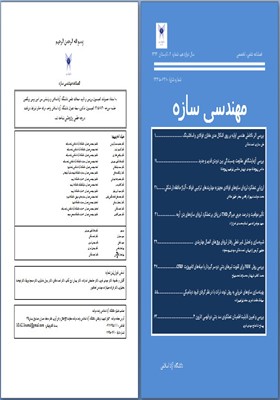بررسی روش NSM برای تقویت تیرهای بتنی دوسر گیردار با میلههای کامپوزیتCFRP
محورهای موضوعی : آنالیز سازه - زلزلهمحمدکاظم شربتدار 1 * , محمدرضا محمدیان 2
1 -
2 -
کلید واژه: میله های FRP, مقاومسازی خمشی. تیر بتن آرمه, کلید واژگان: روش نصب در نزدیکی سطح(NSM),
چکیده مقاله :
ککاشت سطحی میلگرد(NSM) یکی از روش های جدید مقاوم سازی بر اساس خاصیت چسبندگی پلیمر های CFRP به صورت میلگرد درون شیار هایی در قسمت پوشش بتن می باشد. خوردگی و یا کمبود آرماتورها در المان های بتنی، موجب ضعف آن ها تحت بارهای سرویس و زلزله خواهد شد. این شرایط مستلزم مقاوم سازی سازه ها برای افزایش ظرفیت می باشد. استفاده از روشNSM CFRP Bar میتواند موجب افزایش ظرفیت خمشی و برشی المان های بتنی شود. این مقاله شامل جزئیات و نتایج کار آزمایشگاهی و عددی می باشد. در قسمت کار آزمایشگاهی دو نمونه تیر بتنی طراحی و ساخته شد و سپس تحت بار متمرکز در وسط دهانه تست گردید. هر دو نمونه به صورت دوسرگیردار و با مشخصات یکسان بودند. یکی از نمونه ها به عنوان نمونه مرجع و دیگری به روش NSM مقاوم سازی شد. در این مقاله از میله های دست ساز CFRP استفاده شده است که ساخت آن سریع و آسان بوده و در صورت عدم دسترسی به میله های استاندارد FRP، با هزینه بسیار کم و با استفاده از نیروهای کم تجربه قابل تولید در محل می باشد. از نتایج تست آزمایشگاهی جهت کالیبراسیون نمونه های عددی در برنامه ABAQUS استفاده شده است. نتایج حاصل نشان داد که روش NSM یک روش راحت و اقتصادی جهت مقاوم سازی بوده و استفاده از آن در تقویت تیرها، موجب افزایش در ظرفیت باربری، توزیع مناسب ترک ها و کنترل تغییر شکل اعضای تقویت شده می گردد.
Near surface mounted (NSM) is a recent strengthening technique based on bonding carbon fiber reinforced polymer (CFRP) bars (rods or laminate strips) into pre-cut grooves on the concrete cover of the elements to strength. The corrosion or lack of steel bars in reinforced concrete members and the resulting deterioration of structures prompted research on fiber reinforced polymers (FRP) bars as potential reinforcement for concrete members, for use in new construction. These FRP bars can be used to increase flexural and shear capacity of existing concrete members at NSM (Near Surface Mounted) method. The paper presents the details and results of the experimental and numerical programs. Two large-scale reinforced concrete beams were designed, constructed, and tested under one point concentrated loading system. The specimens had two fixed-end support. They were in same size and reinforcement characteristic. A new type of CFRP bar was proposed in this study, the CFRP bars were manually made in laboratory and were hooked at end for anchoring in concrete. The test results has been used to calibrate the analytical models. Moreover extra analytical work has done. The results indicate that FRP bars can be used effectively in existing structures to increase their flexural capacity and change their crack pattern. Photographs taken at selected stages of loading illustrated the performance of each specimen. The force-displacement was presented and compared to find efficiency of FRP bars at NSM method.
_||_

